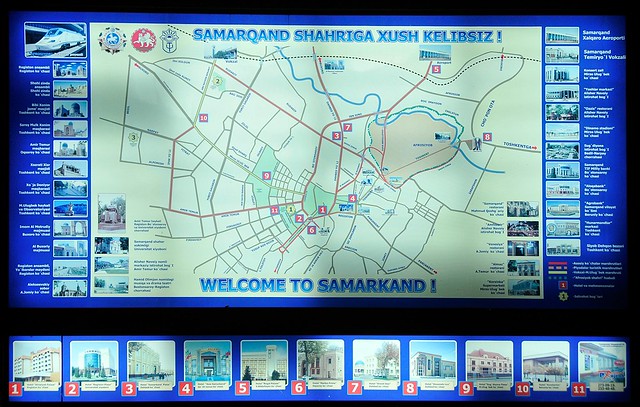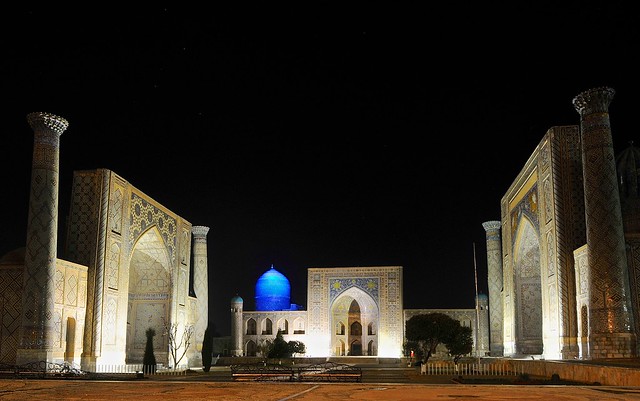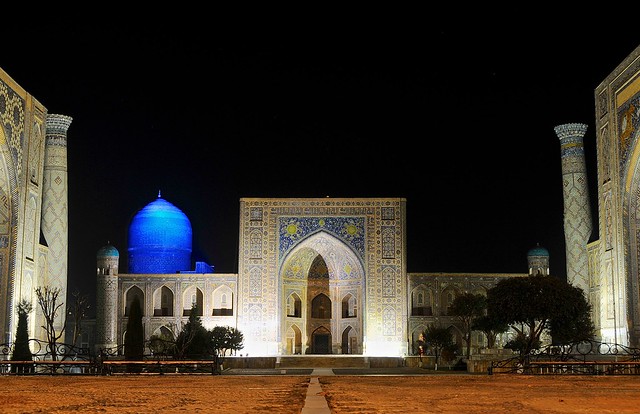The night train to Samarkand departs Tashkent at around 9:00 and arrives in Samarkand shortly after 1:00 in the morning. This is far from ideal, and means I didn't get much sleep on my trip: the smarter thing by far would have been to take the night train all the way to Bukhara, then backtrack to Samarkand, as this would have allowed me to take the night train from Samarkand to Urgench (there's no train from Bukhara to Urgench, as Bukhara is on a different line). A ticket all the way to Bukhara is also only slightly more than simply going to Samarkand, as I paid 40,000 som for a first-class (4-berth kupe) ticket, and all the way to Bukhara would be only 46,000 som.
Anyway, I arrived at Samarkand at about 1:30, woken up by the conductor maybe 15 minutes beforehand. Somewhat surprisingly, there was a large, illuminated billboard map of Samarkand outside the station, in English. We're clearly in a well-touristed place, now, which is a definite difference.
 |
| You know you're back on the tourist trail when you see signs like this. |
The station itself was closed, so I wasn't able to kill
some time in there. But given the map, it was fairly easy to figure out
how to walk over to the central tourist district and the Registan. As I
walked down the road leading to the station, I stopped by one of the
little markets that I was surprised to find still open and grabbed a
quick snack.
I took my time walking into town, and when
I came close to the monuments at around 4:00 I was pleased to find that
many of them are illuminated all night long.
 |
| The first monument on the wwy to the Registan area is the Gur-e-Amir mausoleum, built for Temur/Timur/Tamerlane, who founded the Timurid dynasty which is responsible for most of the monuments in Samarkand. |
 |
| The entrance portal in front of the Gur-e-Amir. |
 |
| The entrance portal in front of the mausoleum. |
 |
| Across from the Gur-e-Amir is another smaller mausoleum, the Rukhobod Mausoleum, which is partially surrounded by this court. As is typical of Uzbekistan today, the stalls now serve as souvenir and craft stores. |
 |
| The Registan is Samarkand's signature monument complex, and is comprised of three madressas built over a period of 250 years. The Ulugh Beg madressa, on the left, was built from 1417-1420, while the opposing Sher-Dor madressa was constructed in 1619-1636. The central Tilya-Kori madressa was constructed in 1646-1660. |
 |
| 5:00 in the morning isn't that bad a time to visit, as it's truly empty at that time. |
 |
| One of the guards for the central building saw me walking around and offered to let me in by selling me a ticket (which was just a used ticket). You can get into most places after hours by bribing people, but I figured it would be better to see everything during the day. |
 |
| The Sher-Dor madressa is famous for the mosaic tigers just above the iwan—portrayal of living beings is forbidden in Islamic art and architecture. |
After looking around the exterior of the Registan, I headed across the street to a small cafe that was open and serving locals. I was pretty surprised that you could have a humble cafe on prime real estate across from what is probably the most famous building in Central Asia, but it really was a cheap, blue-collar sort of establishment.
 |
| Shortly after 7:00, having eaten breakfast, I returned to the park around the Registan to take some more pictures. |
 |
| There's still no one up and about yet. |










